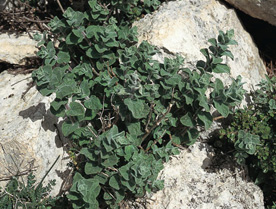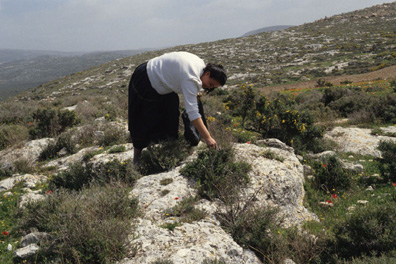

Hyssop flowers in June, near Kufur Sumei, Galilee, Israel.
HYSSOP IS ONE OF THE BETTER-known plants of the Bible: it is referred to in 10 places in the Old Testament and two places in the New Testament. It is not mentioned in the Quran.
This plant, or a product of this plant, formed an important part of Passover: “Take a bunch of hyssop, dip it into the blood in the basin and put some of the blood on the top and on both sides of the door-frame” (Exodus 12:22a, NIV); for ceremonial cleansing of skin disease (Leviticus 14:4); and regarding the red heifer offering: “The priest is to take some cedar wood, hyssop and scarlet wool and throw them onto the burning heifer” (Numbers 19:6, NIV). David mentions hyssop in the Psalms, perhaps in regard to the Numbers sacrifice: “Purge me with hyssop, and I shall be clean: wash me, and I shall be whiter than snow” (Psalm 51:7, KJV).
In the New Testament, Hebrews 9:19 refers to the ceremonial cleansing of the Children of Israel and the use of hyssop. Interestingly, hyssop is not specifically mentioned for this incident in the Old Testament. Another reference, I Kings 4:33, is the only Old Testament verse that does not mention hyssop in a ceremonial use. It is also one of the most puzzling verses dealing with hyssop.
According to Bible verses, hyssop (ezov in Hebrew) has certain features. It can grow on a “wall”: “He [Solomon] described plant life, from the cedar of Lebanon to the hyssop that grows out of walls” (I Kings 4:33a, NIV). The plant and its extracts are useful for purgatives: in both Leviticus 14 and Numbers 19, hyssop is associated with cedar wood, implying a purgative application. Moreover, hyssop may have been commercially available perhaps in the same way it is today.

Hyssop growing near Kufur Yusef, Galilee, Israel, in March. This plant is ready for harvest. As with any native plant, the concentration of flavoring compounds is variable. Therefore, there has been an effort to select flavorful plants for commercial production.

Local people in Northern Galilee harvest hyssop in nature in May. Each household may have a distinct recipe for preparing it as a spice.
For all of these uses, Origanum syriacum, a plant known in English as Syrian hyssop and a relative of the well-known kitchen herbs oregano and marjoram, seems the most likely candidate for the hyssop of the Bible. Hyssop does not grow in Egypt nor is it recorded from any archaeological finds (de Vartavan and Amorós 1997), though it has been found growing in Sinai (Fleisher and Fleisher 1988).
Modern Bible scholars still express uncertainty about the actual identity of hyssop, and some suggest that it could be caper (Capparis spinosa), a common shrub in the Middle East (Moldenke and Moldenke 1952). The only evidence for this possibility is the verse in I Kings 4 that refers to hyssop (ezov) growing from a wall. The wall has often been assumed to be of masonry, similar to walls in the older parts of cities in the Middle East and on which caper is commonly seen growing. This interpretation, however, does not fit Origanum syriacum, since it does not grow out of stone walls. To suggest, however, that Solomon was thinking of caper, only complicates the matter, since caper in Hebrew is a different word, ab’ionah.
Another issue with caper is how it is used. The fruit, a soft berrylike structure when mature, was apparently used as an aphrodisiac. Since caper is armed and the leaves are waxy, it would not be suitable as an applicator as required in the Exodus 12 account. Palestinians I have interviewed do not use any part of the caper plant as a food or condiment.
Hyssop, Origanum syriacum, known in Arabic as za’atar, on the other hand, is one of the most widely used and valued herbs in the Middle East. A typical Arab breakfast is bread dipped in olive oil and za’atar. The leaves are available in dried form in Arab markets as a mixture of hyssop, sesame seeds, salt, and sometimes olive oil and other ingredients. The flavor is rather like that of pizza. I asked the Samaritans, native Arabic speakers, on Mount Gerizim, which plant they use for sprinkling in their Passover rites, and their answer was za’atar.
Add another issue to the pot: in I Kings 4:33, the Hebrew word qir, which has been translated as “wall,” is worth examining. The word is often used to mean “wall” (Leviticus 14:37; I Kings 6:5), but that does not preclude the possibility that the word, in I Kings, refers to natural ledges that are common in the mountains. In this verse, Solomon is speaking of natural history, not manmade objects, so a masonry wall would be out of context. Indeed Origanum syriacum frequents rocky ledges and outcrops in the mountains, natural formations that can reasonably be described as wall-like.
Another problem in deciphering the identity of hyssop remains, as indicated in the other New Testament verse: “A jar of wine vinegar was there, so they soaked a sponge in it, put the sponge on a stalk of the hyssop plant, and lifted it to Jesus’s lips” (John 19:29, NIV). The word here is the same as that in Hebrews 9:19, and there seems little doubt that hyssop is meant. The problem is how the plant was used. First, the sponge was put on a long stalk of the hyssop plant, which is unlikely because of the small stature of hyssop; it would nearly be impossible to find a stem more than 1 meter (3 feet) long and even then stems often branch. The Greek words meaning “binding it to hyssop” might also suggest that the hyssop plant was a holder for the sponge—plausible because of the branching growth habit of the hyssop. But why this holder would be necessary is unclear.
Hyssop, then, was used in Bible times for worship. Today, it is a widely consumed herb, a use not mentioned in the Bible. The plant is another example of a member of the Middle East native flora finding a place in the scriptures as well as in kitchens of today.